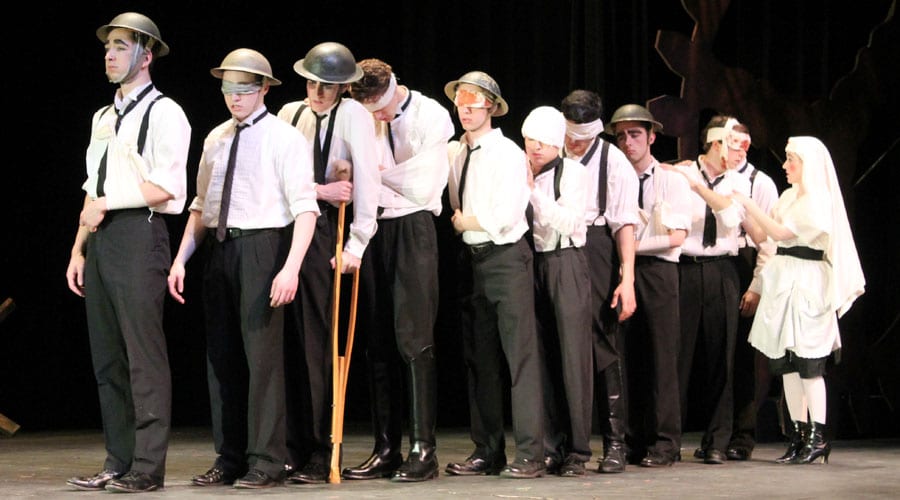
If gore and fear are clichéd techniques for keeping historical events current, what other approach can reawaken an audience’s horror? Joan Littlewood’s “Oh, What a Lovely War!,” recently revived by the St. Olaf Theater department and directed by Artist in Residence Gary Gisselman, argues that the answer is farcical comedy.
Through its outrageous humor, a position-oriented setting and ominous electronic headlines that tally the causalities of World War I, Gisselman’s production haunts the audience with the realization that war will never have a true victor.
Originally written to honor the 50th anniversary of World War I, “Oh What a Lovely War” explores the politics that led to the war, the reality of life both in the trenches and back home, the propaganda used to sustain both sides and the pointlessness of it all in the end.
Rather than following one solider through the war as many war memoirs do, the play calls for a circus master, Andy Lindvall ’14, who conducts goofy “war game” charades and keeps the audience invested. The show functions as a startling collage of experiences: soldier’s written works, statistics and song parodies from the 1900s that the cast ensemble effectively carries. These vignettes are shockingly interrupted by comical sequences that keep the audience from crying.
This nonsensical humor never feels insensitive but rather blurs the historical connection to the present enough that the audience does not realize what a terrible event they are laughing at.
One example includes soldiers in bayonet training who must hold their rifles in between their legs. One accidently shoots open a red umbrella, revealing his lack of a weapon. Other examples include stereotypical, country-specific step-dancing, bushy mustaches and jokes tailored to the St. Olaf audience. By the end of the first act, I felt guilty for having laughed at the subject matter, yet I knew that there was no way around it: It was just too hilarious to ignore. This contrast between loss and comedy proved to be the tension that would blossom into shellshock by the production’s end.
One way that this contrast was implemented was through the stark and mechanical setting that expressed the systematic nature of war. With commanders often standing on the balconies, the audience was positioned in effectively the same trenches as the soldiers. This view not only encouraged sympathy but also gave the audience a clear view of the historical photographs that displayed center stage. It also placed the audience beneath the headlines scrolling numbers of losses, leaving us forever looking up for progress or hope.
The stage itself was covered in cogs, one of which was placed upside down near the back where a structural beam lined up with the center third to create an upside down peace sign. Whether it was intentional or not, its ironic presence summarized the message of the play.
Finally, the production diverged from the script and rewrote the ending to force the audience to reexamine the philosophies of war. Following the heart-wrenching ode “Adieu la vie,” which included the whole cast, a recording of the cast naming every war and military conflict in recorded history played. With each named conflict, a cast member fell to the ground.
In the end, some were left standing to carry on, but far more had fallen. This culmination of wars reminds us of how many times we have sought to fix our differences through war and how many times we have failed.
By the end, I was at a loss. A loss of words, thought, spirit and heart. All that was left in my mind were thoughts of complete bewilderment over the gravity of the tragedy and sympathy for the fallen. Such is the mark of an effectively powerful production.
While many a history class covers World War I, it is easy to forget about the impact of the “Great War” when we often place the focus on World War II or more recent conflicts. World War I, however, destroyed an entire generation, left parts of the world broken and introduced mechanical harbingers of death the likes of which the world had never previously known. For these reasons and so many more, it is of the utmost importance that we do not forget the lesson we as a world learned from it: War has no winner in the end.
pilkingt@stolaf.edu
Photo Credit: HANNAH RECTOR/MANITOU MESSENGER

